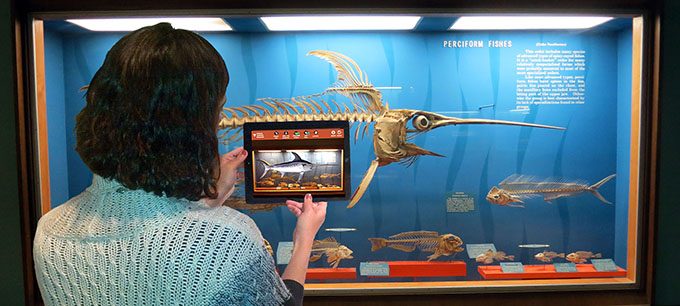Augmented Reality Brings Spaces to Life
This augmented reality application we developed allows visitors to view the constructed wetlands outside of the Ralph Klein Park Environmental Education and Ethics Centre and interact with points that reveal overlaid visuals of the constructed wetland features and wildlife.
Augmented reality (AR) is a technology that enables us to apply a layer of digital content over what we see in the real world. Museums as well as science and interpretive centres began embracing the technology years ago to enhance their exhibits with multimedia content geared toward digitally-minded visitors. In many ways, the applications that have been developed for museums and like institutions have set the pace for the creative solutions that are possible with this technology.
What makes augmented reality attractive for these types of environments (more so than virtual reality) is that it can enhance visitor experience without patrons becoming fully immersed in a digital experience that may detract from the actual exhibit collections and galleries – not to mention the social interaction aspect – that they came for. Augmented reality apps can provide a contextual layer of information, imagery, animation / video, and audio to objects, exhibits, outdoor landscapes, and specific spatial points in the physical world.
Augmented reality applications can utilize the sensors on mobile devices to trigger and track the positioning of digital visuals that are composited over views of the physical world (captured from the camera) based on proximity using GPS and ibeacons as well as gyroscope / compass rotation. The camera can also be used to read and trigger actions from QR codes as well as other visual recognition functions that can be integrated.
The Skin & Bones AR app at the Smithsonian National Museum of Natural History superimposes virtual digital media over the physical exhibits. For instance, the app overlays creatures’ skeletons with visuals of how they looked when they were alive.
 Image: Smithsonian
Image: Smithsonian
There are numerous possibilities for how AR experiences can be developed with different hardware, sensors, and digital media. While there have been some challenges with accuracy and limitations of the mobile device sensors, beacons, and other hardware, they have improved over time, and there are positive signs that the technology continues to mature.
A number of the largest tech companies have been investing in research and development of new wearable AR gear that will significantly heighten the level of detail and accuracy of merging interactive 2D / 3D digital media with the physical space. With some products the lines between AR and VR will likely blur more in the future. This will lead to the ability to develop more innovative applications focused on education, gaming, and visualization that will be capable of augmenting experiences in the physical world more accurately.
Augmented reality is particularly popular with children who are keen on playing with new technology and AR experiences are commonly geared towards them. A layer of contextual multimedia content can provide various means of engagement with increased retention of educational content, social learning interactions, and entertainment value. With continual improvements, the possibilities and potential for AR experiences for museums, cultural / science / interpretive centres, and other institutions in the future are endless.


